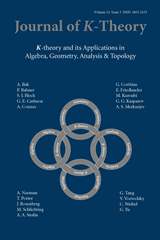Article contents
The additivity of traces in monoidal derivators
Published online by Cambridge University Press: 14 July 2014
Abstract
Motivated by traces of matrices and Euler characteristics of topological spaces, we expect abstract traces in a symmetric monoidal category to be “additive”. When the category is “stable” in some sense, additivity along cofiber sequences is a question about the interaction of stability and the monoidal structure.
May proved such an additivity theorem when the stable structure is a triangulation, based on new axioms for monoidal triangulated categories. in this paper we use stable derivators instead, which are a different model for “stable homotopy theories”. We define and study monoidal structures on derivators, providing a context to describe the interplay between stability and monoidal structure using only ordinary category theory and universal properties. We can then perform May's proof of the additivity of traces in a closed monoidal stable derivator without needing extra axioms, as all the needed compatibility is automatic.
Keywords
- Type
- Research Article
- Information
- Copyright
- Copyright © ISOPP 2014
References
REFERENCES
- 12
- Cited by




